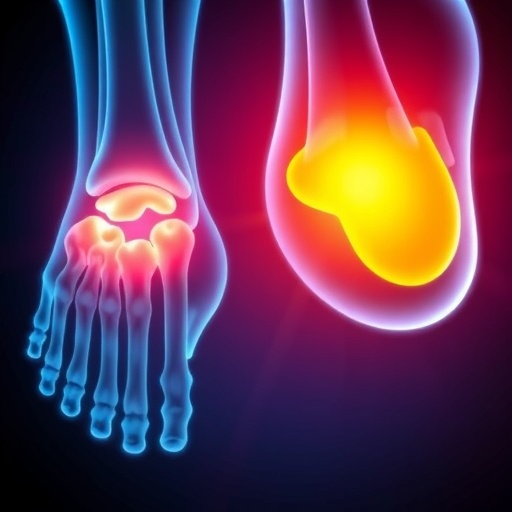In a groundbreaking advancement in forensic science, researchers have unveiled a novel method for age estimation through the detailed analysis of computed tomography (CT) images of the thoracic cage, specifically targeting a Mediterranean population. This innovative approach signifies a major leap forward in the accuracy and reliability of age determination, a critical aspect in forensic investigations, legal medicine, and anthropological studies.
Traditionally, forensic age estimation has relied heavily on dental examination, ossification centers in bones, or external morphological traits, which often present limitations due to population specificity and varying environmental influences. The thoracic cage, comprising the sternum, ribs, and thoracic vertebrae, however, serves as a robust anatomical structure that undergoes distinct morphological and physiological changes throughout an individual’s lifespan. Leveraging CT imaging technology allows for a non-invasive, highly precise examination of these skeletal features in three-dimensional space, opening new vistas for forensic experts.
The research conducted by Partido Navadijo, Borja Miranda, Navarro Merino, and their colleagues meticulously analyzed the thoracic cage morphology captured by advanced CT scans in a representative cohort of Mediterranean individuals. By focusing on this demographic, the study addresses the crucial need for population-specific reference data in forensic age estimation, recognizing that genetic, environmental, and lifestyle factors uniquely influence skeletal development and degeneration in different populations.
One of the pivotal aspects of this study was the use of sophisticated image processing algorithms to extract quantifiable parameters from the CT data. These parameters include rib cortical thickness, sternal body morphology, and intercostal space variations, each correlating with distinct age-related transformations. By applying machine learning techniques to these datasets, the researchers developed predictive models that demonstrate superior accuracy compared to classical biometric methods.
The thoracic cage presents a complex biomechanical system, and its structural changes with age reflect both physiological growth and senescence. For instance, the ossification processes in the sternum and ribs, changes in bone mineral density, and morphological adaptations to respiratory mechanics all contribute to measurable indicators of age. This study’s integration of these variables into an analytical framework represents a sophisticated synthesis of anatomical, radiological, and computational sciences.
A significant advantage of using CT imaging is its ability to distinguish between subtle developmental stages and degenerative markers, which are often indistinguishable through standard radiographic techniques. The volumetric resolution of CT scans permits the detection of microstructural changes in bone tissue, providing forensic practitioners with a detailed matrix of age-dependent features. This precision is particularly beneficial when skeletal remains are incomplete or fragmented, a common challenge in forensic contexts.
Moreover, the study emphasizes the importance of constructing age estimation models that accommodate the continuous nature of skeletal maturation and decay, rather than relying solely on categorical age brackets. This approach aligns with modern forensic anthropology’s shift towards probabilistic and statistical models, enhancing the reproducibility and validity of age assessments across diverse cases.
Importantly, the research highlights sex-specific variations in thoracic cage aging patterns. Male and female skeletal systems demonstrate differential trajectories in bone density loss, rib morphology, and ossification timing, underscoring the necessity for gender-adjusted models. The inclusion of these variables further refines the predictive accuracy and addresses forensic requirements for specificity and individualization.
Technological advancements in imaging hardware and software have been instrumental in enabling this research. High-resolution multi-slice CT scanners, coupled with cutting-edge 3D reconstruction algorithms, have made possible the non-destructive, in situ investigation of skeletal features with unprecedented clarity. The application of such technology in a forensic setting not only improves age estimation outcomes but also preserves valuable biological evidence for future analyses.
Another compelling facet of this research lies in its potential to contribute to the identification of unknown decedents in medico-legal investigations, mass disaster scenarios, and archaeological findings. Age is a critical parameter in constructing biological profiles, and by expanding the toolkit available for its determination, forensic scientists can achieve more confident identifications, facilitating justice and closure for families.
While the study yields promising results, the authors acknowledge limitations inherent to their research, such as sample size constraints and potential population substructure effects. They advocate for further validation studies involving larger, more diverse cohorts to establish standardized protocols applicable across different geographical and ethnic groups. This call to action signals a broader movement toward harmonized forensic methodologies worldwide.
Ethical considerations also underpin the deployment of CT imaging for age estimation. The non-invasive nature of this technique reduces ethical concerns associated with destructive sampling methods previously employed in forensic and anthropological research. Furthermore, modern data protection standards ensure that imaging data is handled with the highest regard for individual privacy and consent.
Intriguingly, the analytical models devised in this study could have cross-disciplinary applications beyond forensic science. Clinical medicine, particularly gerontology and orthopedics, may benefit from improved understanding of thoracic cage aging processes, informing diagnostics and treatment planning. Additionally, paleoanthropologists could apply similar methodologies to fossil records, elucidating life history traits of ancient populations.
The integration of artificial intelligence and advanced computational modeling in this research exemplifies the transformative impact of digital technologies on traditional disciplines. By harnessing big data analytics with high-fidelity imaging, forensic practitioners are equipped to transcend previous limitations, achieving a level of precision that was once unattainable.
Conclusively, this pioneering study not only advances the forensic community’s capability in age estimation but also sets a precedent for future explorations combining medical imaging and computational sciences. It paves the way for the development of universal, validated, and ethically sound protocols, reinforcing the scientific backbone of legal medicine and fostering innovation at the intersection of technology and human biology.
As the scientific community anticipates the broader application of these findings, it becomes evident that age estimation via thoracic cage CT image analysis represents a crucial evolution in forensic methodologies. This evolution promises enhanced accuracy, operational efficiency, and adaptability—qualities indispensable to the dynamic needs of modern forensic investigation.
The implications extend beyond the immediate forensic domain, promising to enrich our understanding of human anatomical aging and its variability across populations. With ongoing research and technological refinement, such methodologies will likely become a cornerstone of age estimation practices, ultimately contributing to the convergence of biological sciences, technology, and legal medicine in unprecedented ways.
Subject of Research: Age estimation using CT imaging of the thoracic cage in a Mediterranean population
Article Title: Age estimation through CT image analysis of the thoracic cage in a Mediterranean population
Article References:
Partido Navadijo, M., Borja Miranda, E.A., Navarro Merino, F. et al. Age estimation through CT image analysis of the thoracic cage in a Mediterranean population. Int J Legal Med (2025). https://doi.org/10.1007/s00414-025-03660-6
Image Credits: AI Generated
DOI: https://doi.org/10.1007/s00414-025-03660-6
Tags: age estimation in Mediterraneansanthropological studies in forensicscomputed tomography in forensicsCT thoracic cage analysisforensic science advancementslegal medicine applicationsMediterranean demographic researchmorphological changes in thoracic cagenon-invasive age determinationpopulation-specific reference dataprecision imaging techniquesskeletal morphology assessment





